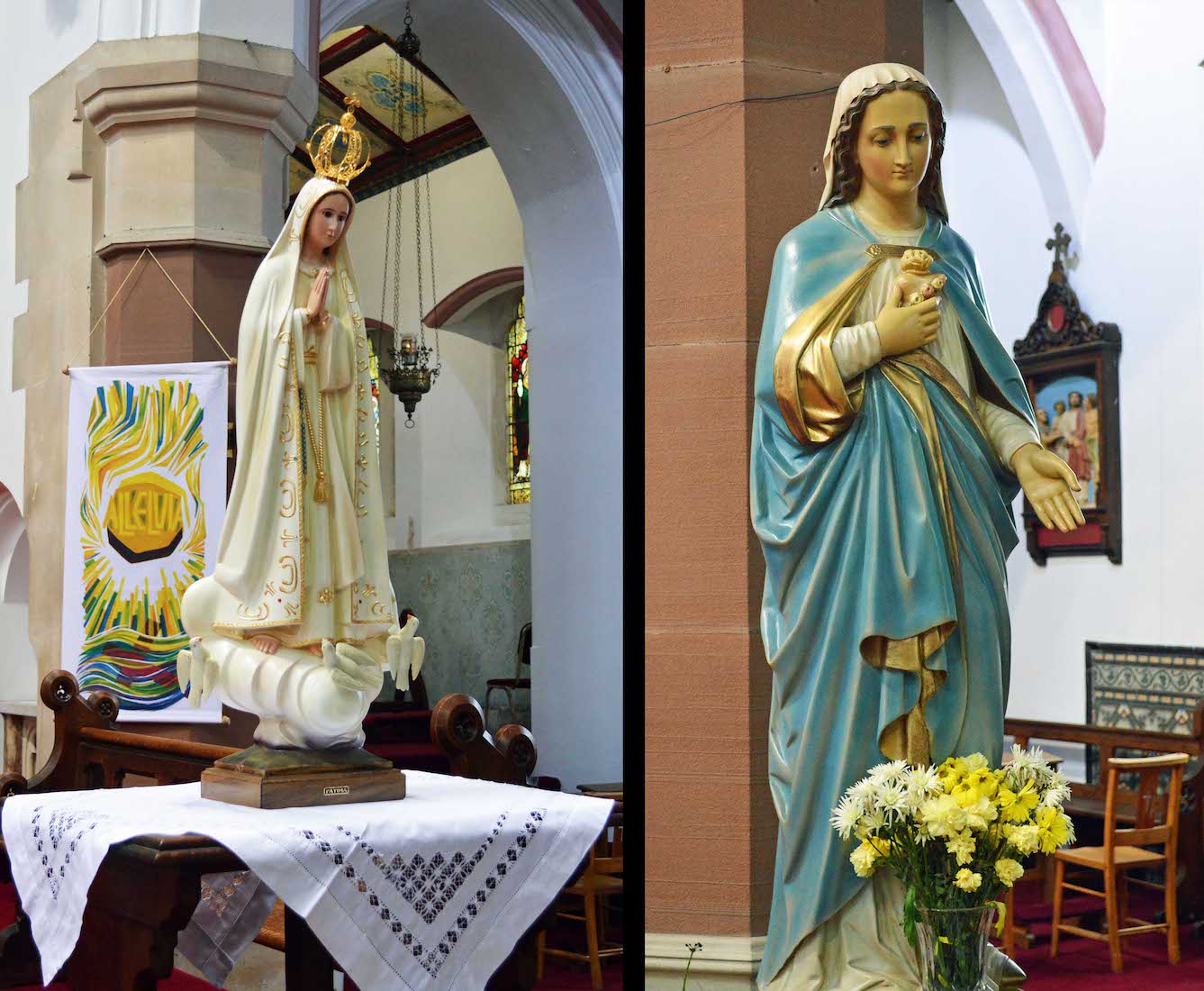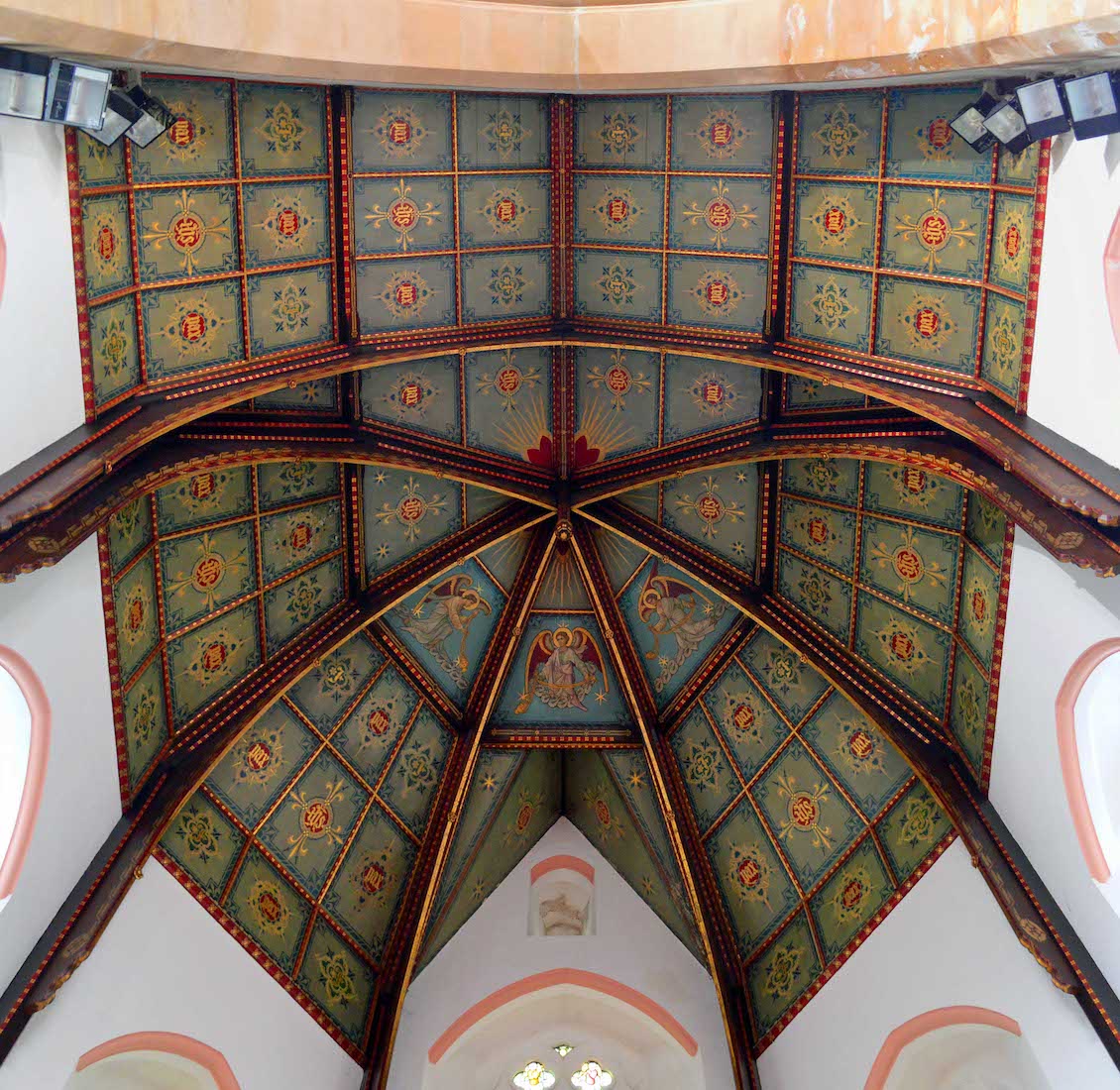41. LADY OF FATIMA, VIRGIN MARY

At right is a more conventional statue of the Virgin Mary, but clutching a heart? At left is a statue of Our Lady of Fátima, a Catholic title of the Blessed Virgin Mary based on the famed Marian apparitions reported in 1917 by three shepherd children in Fátima, Portugal. Beginning in the spring of 1917, the children reported apparitions of an Angel, and starting in May 1917, apparitions of the Virgin Mary, whom the children described as ‘the Lady more brilliant than the Sun’.
42. NAVE ALTAR

That nave altar is also attractive, with marble columns matching the pulpit. The central panel bears the image of the Lamb with flag, and below, the text ‘SANCTUS’ (HOLY). After the meetings of Vatican II in the early ’60s, it was agreed that Catholic mass should be administered from the nave altar rather than from the high altar as previously.
43. SANCTUARY BANNERS
There are two further colourful banners in the sanctuary area. One shows the women approaching the open tomb after the resurrection of Christ. The other banner has a praise theme, with the central word ‘Alleluia’.
44. HIGH IMAGES
There is a carved figure standing on each side of the sanctuary arch. The figure at right holding a clover leaf is St Patrick. The figure at left may be St Benedict.
45. RETABLE
A small table near the nave altar supports a Bible or prayer book. Such tables are often used to provide extra flat space during the celebration of the Eucharist.
46. INNER SANCTUARY
After the colour and interest of the nave, I find the inner sanctuary disappointingly grey and uniform. The side walls are covered with plain curtaining – a temporary measure? Apparently the cathedra replaced the high altar in 1987 when the Church became a Cathedral, but I think the reredos is unchanged. The lovely stained glass windows and the ornate vaulting above speak of past grandeur.
47. CRUCIFIX AND BANNERS
There is a white and gold banner on either side of the reredos. Each alludes to a sunburst, with the Lamb and Flag image at left, and the Chi-Rho symbol for Christ at the right. At centre is a golden crucifix; there might be a discussion about the blood realism.
48. CATHEDRA
A simple cathedra stands against the back (East) wall. Above it is the coat of arms of the recent Bishop with the fine motto ‘Non ministrari sed ministrari’ (Not to be served but to serve). The last Bishop was Bishop Thomas Matthew Burns, S.M. (2008 – 2019). The cathedra is the throne of the bishop, and the location of this cathedra in this church signifies it is a cathedral.
49. REREDOS
The grey reredos is adorned with several shields and a number of small ornaments. There are also two angels – standing in niches bordered by marble columns, matching pulpit and nave altar.
50. CORNER FIGURES
The angels are likely to be archangels, so the one on the left will be the Archangel Michael. The figure on the right, holding a lily will be the Archangel Gabriel.
51. ROOF SUPPORT FIGURES
The vaulted roof of the sanctuary has long descending wall supports, each with a face or shield at the lower end. Each shield contains initials and a date. So for example we have 1875 FWR, and 1875 was the date Father Wulstan Richards became the first priest. Some help filling in the remaining details would be appreciated!
52. SANCTUARY VAULTING
This beautifully painted vaulted ceiling of the sanctuary is quite magnificent. As with the chapels it is made up of rectangular painted panels with central logos of ‘pax’, ‘ihs’, ‘j’. The colouring of the top section is blue rather than green, and three angelic figures are depicted.
53. VAULTING DETAIL
This close up detail of the vaulting shows three angels dispensing incense.
54. SANCTUARY WINDOWS
There are three colourful East windows. At left is an image of Joseph and Mary and the baby Jesus. The central window shows the Risen Christ appearing with the angels to disciples and followers below. The window at right is more difficult. The figure at left fits with the story of St Christopher carrying the Christ Child across a river. The right figure is an elderly bishop carrying documents marked ‘Acta Synodi de Brevi’ (Council acted quickly!). This completes our tour of Menevia Cathedral.

CONCLUSION
I hope you have enjoyed visiting Menevia Cathedral, Swansea with me. I received a friendly welcome here.
I am happy to receive constructive comments or corrections concerning this website. The best websites are the ones which have no errors! I am grateful to my wife Margie who has proof-read these pages.
I have found it difficult to find much background on this Cathedral, apart from a little history supplied on the Cathedral website. There are a number of gaps in this presentation, and I would be glad to receive any additional information about the Cathedral building.
The link for the Cathedral website is:
The photographs which appear on this site can also be found in higher resolution at:
https://www.flickr.com/photos/paulscottinfo/albums/
Paul Scott Site created 01 / 2020












